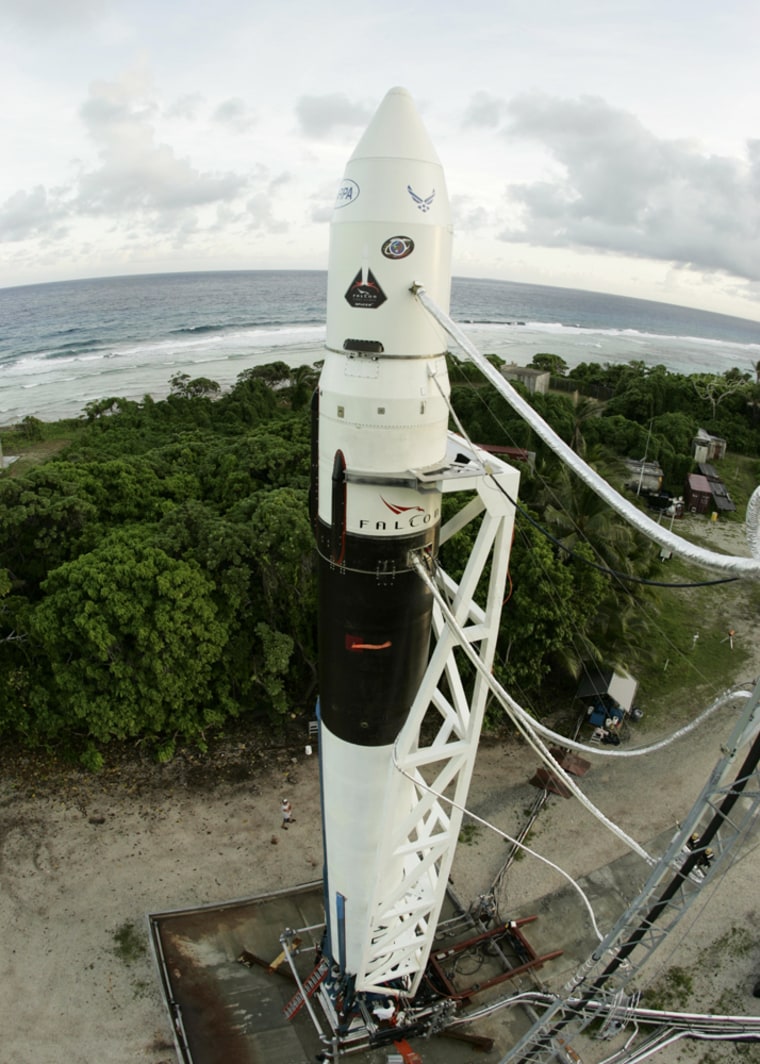Three weeks after its first try fizzled out, a low-cost rocket company had to postpone its maiden launch once again on Monday when a faulty valve created a dent in the rocket's fuel tank.
Space Exploration Technologies, or SpaceX, fueled up its partially reusable Falcon 1 rocket for liftoff from Kwajalein Atoll in the Pacific Ocean, on a mission to put the FalconSat 2 plasma-monitoring satellite into orbit for the U.S. Air Force Academy.
But just after Monday's launch window opened, mission controllers had to scrub the launch because the rocket suffered structural damage, Gwynne Shotwell, SpaceX's vice president of business development, said from the company's headquarters in El Segundo, Calif.
She quoted an e-mail sent from the launch site by Elon Musk, SpaceX's founder and chief executive officer: "Launch is scrubbed for the year. We noticed a structural issue with the first-stage fuel tank that will require repair."
Later, in an update to the SpaceX Web site, Musk expanded upon the apparent cause of the damage:
"Due to high winds, we placed the countdown on hold and began draining the fuel tank. As we drained fuel from the first-stage tank, a faulty pressurization valve caused a vacuum condition in the tank. This caused a fuel tank barrel section to deform and suck slightly inward. It is important to note that the root cause is an electrical fault with a valve, not structural design. At this point, it appears that no other damage was sustained to the vehicle or the satellite."
Musk said that the rocket would undergo closer inspection and that the initial damage assessment might be revised after further analysis. Engineers would "do another full review of all the vehicle systems, including propulsion, structures, avionics, software and ground support systems," Musk said.
"Therefore, I expect that the earliest that launch would occur is late January," he said. "Third time's the charm."
Low-cost liftoffsSpaceX is hoping that the launch, funded by the Defense Advance Research Projects Agency as well as the Air Force, will be the first in a series of low-cost liftoffs from Kwajalein as well as Vandenberg Air Force Base in California. The estimated price tag for a Falcon 1 launch is about $6.7 million, far less than the cost of similar launches by more established companies.
The company already has won a military contract worth up to $100 million for small-scale launches through 2010, and it is developing fully reusable, beefed-up versions of the Falcon rocket capable of lofting payloads and people to the international space station and beyond.
But all those grand plans depend on getting that first Falcon 1 safely off the ground. The company came within minutes of blastoff during its first countdown on Nov. 26, but a series of glitches forced postponement.
Fixing the glitches
Before Monday's countdown, Musk said the earlier attempt had to be called off because of a computer anomaly as well as a liquid oxygen leak at the launch pad. Musk said both those problems were easily fixed: For example, the liquid oxygen was found to have boiled off through a valve that was inadvertently left open.
For Monday's launch attempt, Musk said enough liquid oxygen was shipped in "to fill the rocket four or five times over." He also said the countdown sequence has been "upgraded and improved" to allow for quicker launch preparations and more efficient computer control.
Monday's launch window opened at 2 p.m. ET and was due close at 10 p.m. — meaning that SpaceX had twice as much time available for launch as it did in November. SpaceX must accommodate the U.S. military's schedule, since the launch site in Kwajalein is also used for tests of the Pentagon's National Missile Defense System. Operations at the site are being shut down later this week for the holidays.
If SpaceX's first launch is successful, the second launch is due to take place from Vandenberg in the first quarter of 2006. That mission would put the TacSat 1 military communications satellite into orbit — as well as a Space Services memorial payload, including the remains of Mercury astronaut Gordon Cooper and "Star Trek" actor James Doohan.
$100 million invested
Musk — who made his fortune by founding, then selling, the PayPal online payment company — told reporters at a briefing last month that he has put nearly $100 million into SpaceX over the past three years.
The road has not always been smooth: SpaceX has had to deal with engine problems during testing, as well as legal snags over its engine technology and the use of Vandenberg's rocket range. SpaceX is taking on the aerospace giants in court as well as in the marketplace: The company has filed a lawsuit against the Boeing Co. and Lockheed Martin, contending that their proposed joint venture to seek government launch contracts would violate antitrust laws.
Musk says he isn't in this just for the money: Even before developing the Falcon 1 rocket, Musk provided funding for private-sector research aimed at opening the way for future human missions to Mars, and during last month's briefing, he said his efforts were aimed ultimately at helping humanity become a "multiplanet species."
"Life has a duty to extend itself," Musk told reporters, "and we, as life’s representatives, should do so."
